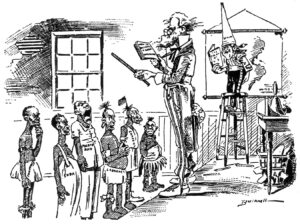What were the cultural meanings assigned to Caribbean populations by Americans at the turn of the 20th century? Why is it so difficult to make sense of visual representations produced in the past? How can we “read” political cartoons? In what ways can political cartoons convey a political issue or standpoint? How similar or different is it to read political cartoons in the 1890s versus political ads or memes on the Internet today? These are some of the questions I am hoping teachings can help students answer as they work with two 1898 American political cartoons: “First in Class in United States”, published by The Cincinnati Post, and an uncaptioned political cartoon (referred to by scholars as “Uncle Sam and His Women”), published by The St. Louis Globe-Democrat.
Both “First in Class in the United States” and “Uncle Sam and His Women” (we will use the title given by scholars), which will be part of the collection I will be creating for HIST89’s final project, are effective in exemplifying the two main themes I would like students to explore: (1) American Imaginings of the Caribbean and the (2) Use of Political Cartoons as Historical Sources.
These images belong to a period where cartoonists were reconfiguring the concepts of democracy, justice, and freedom, to suit the American imperial consciousness back in 1898. The Spanish-American War defined a new era for United States expansionism, where Puerto Rico, Cuba, Guam, and the Philippines would become colonial territories. Cartoons such as “First Class in the United States” and “Uncle Sam and His Women” contain all the elements needed to understand how such a medium helped shape a positive attitude towards a war against Spain. Even though they were short-lived, these American depictions of Caribbean populations have made a lasting impact still felt today. I would like for students to ask more complex questions on U.S.-Caribbean relations and on U.S.-Latinx socio-political dynamics.
They can be of great use for developing historical thinking skills. Their value as primary sources lie, not so much on their factual content or on their ability to entertain (mass media has blossomed by then), but on their persuasive power to shape public opinion with one quick glance. Both “First in Class in the United States” and “Uncle Sam and His Women” promote political views and perceptions of the times with regard to the 1898 War and leave an impression on readers who may have been unsure about American expansionism (and colonialism), but felt good about the U.S. helping other nations achieve progress.
Political cartoons might be perceived as simpler than text to evaluate, this medium is quite complex to decode, and these two images may be great ways to exemplify that challenge. Not only would students have to understand the historical context of 1898, they would also need to become comfortable with cartoonists’ rhetoric, one that juxtaposes, humor, exaggeration, and misery. The fact one cartoon was accompanied by text while the other one did not, can make the evaluation of this primary source an even more interesting one, but I am hoping to see how students can benefit or feel more challenged by this difference, or might generate different paths of inquiry.
To help students analyze both visual representations, I will provide some historical context on the events leading to the 1898 War, on the U.S. relations with the Caribbean (particularly, Puerto Rico and Cuba), and on American journalism. There will be a gallery of political cartoons in the era, which will help visualize the overall narrative produced through this medium. In addition, I will provide information on how to work with political cartoons as primary sources, including the article, “Images of Empire: Popular Representations of the 1898 War.” (Gleach), which will help instructors facilitate a discussion on how to best approach and “read” political cartoons. Through both images, I hope students can begin to understand the cultural meanings that Americans assigned to Caribbean populations during the 1898 War. Gleach’s article, which includes an approach to reading these cartoons, will help students make sense of visual representations produced in the past.
Also, if time permits, I would like to include other forms of historical evidence for students to situate themselves within a larger context. Some examples might include:
-the editorial piece by the New York Evening Post published on March 21, 1889, entitled “Do we need Cuba?”. This article, which was originally published in the Philadelphia Manufacturer, produces a similar narrative as the two political cartoons
– the article, “A Vindication of Cuba,” by Cuban poet and revolutionary José Martí, and published New York Evening Post, March 25, 1889. This is Martí’s response to “Do we Need Cuba?”
-an anti-imperialism article from the era
-a couple of articles published in the past five years that relate to the aforementioned themes

